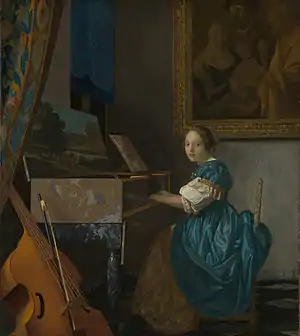Lady Seated at a Virginal
Lady Seated at a Virginal (Dutch: Zittende virginaalspeelster), also known as Young Woman Seated at a Virginal, is a genre painting created by the Dutch Golden Age painter Johannes Vermeer in about 1670–1672 and now in the National Gallery, London.[2]
| Lady Seated at a Virginal | |
|---|---|
 | |
| Artist | Johannes Vermeer |
| Year | c. 1670–1672[1] |
| Medium | Oil on canvas |
| Movement | Dutch Golden Age painting |
| Dimensions | 51.5 cm × 45.5 cm (20.3 in × 17.9 in)[1] |
| Location | National Gallery, London |
Lady Seated at a Virginal
Another painting, probably also by Johannes Vermeer known as A Young Woman Seated at the Virginals, belongs to a private collection shows also a young woman seated at a virginal. This painting and Lady Seated at a Virginal are quite separate works and are each known by alternate names and confusion between those two pieces may exist.
Description
The picture shows a woman facing left and playing a virginal. In the left foreground is a viola da gamba holding a bow between its strings.[2] A landscape is painted on the inside lid of the virginal, and the painting on the wall is either the original or a copy of The Procuress by Dirck van Baburen (c. 1622, now in the Museum of Fine Arts in Boston), which belonged to Vermeer's mother-in-law.[2] The Dimensions of the painting is 51.5 cm (20.3 in) height and 45.5 cm (17.9 in) width.
Commentary
Because of its style, the painting has been dated to about 1670. It has been suggested that it and Lady Standing at a Virginal (also owned by the National Gallery) may have been created as pendants, because their sizes, date and subject matter are all similar. A recent study has shown that the canvas for the two paintings came from the same bolt.[3] In addition, the ground applied to the canvas appears identical to that used for both the Lady Standing and the New York Young Woman Seated.[4] However their provenances before the 19th century differ, and Vermeer sometimes varied a theme in otherwise unrelated paintings. In the 19th century, both paintings were owned by the art critic Théophile Thoré, whose writings led to a resurgence of interest in Vermeer starting in 1866. The painting entered the National Gallery with the Salting Bequest in 1910.[2]
The painting is one of several works by Vermeer featuring keyboard instruments, including The Music Lesson, The Concert, and Lady Standing at a Virginal. Scholars believe these may all be based on the same instrument, built by Johannes Ruckers.[5][6]
See also
| Wikimedia Commons has media related to A young woman seated at a virginal (London). |
References
- "Key facts: A Young Woman seated at a Virginal". National Gallery (London) web site. Archived from the original on 8 July 2009. Retrieved 20 September 2009.
- "A Young Woman Seated at a Virginal". National Gallery, London web site. Retrieved 20 September 2009.
- Liedtke, Walter; Johnson, C. Richard, Jr.; Johnson, Don H. "Canvas matches in Vermeer: a case study in the computer analysis of canvas supports" (PDF). Retrieved 5 May 2013.
- Sheldon, Libby; Costaras, Nicolas (2006). "Johannes Vermeer's Young Woman Seated at a Virginal". Burlington Magazine. 148: 89–97.
- Bennett, William Ralph Jr. (4 September 2018). The Science of Musical Sound. Springer. p. 82. ISBN 9783319927961.
- Huerta, Robert D. (2003). Giants of Delft: Johannes Vermeer and the Natural Philosophers : the Parallel Search for Knowledge During the Age of Discovery. Bucknell University Press. p. 105. ISBN 9780838755389.
Further reading
- Liedtke, Walter A. (2001). Vermeer and the Delft School. Metropolitan Museum of Art. ISBN 978-0-87099-973-4.